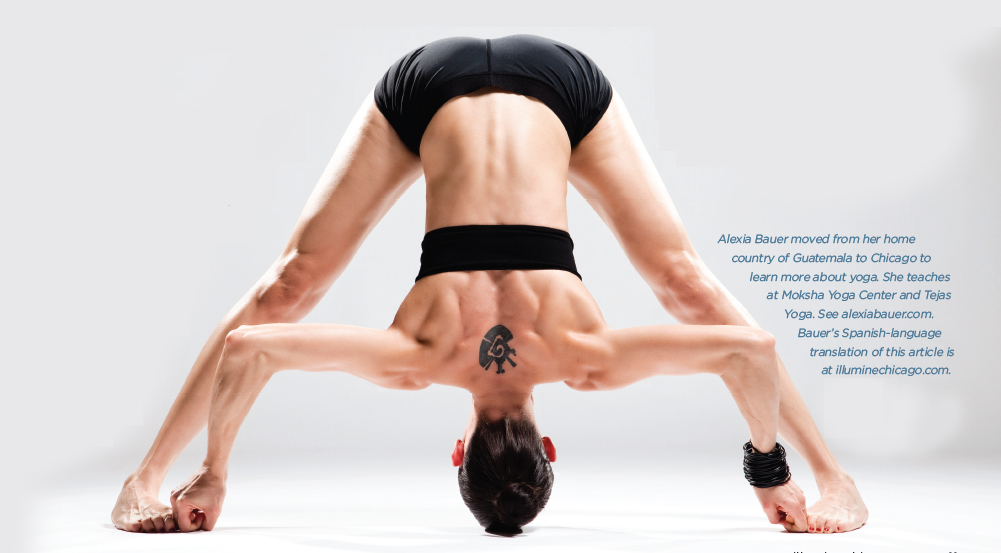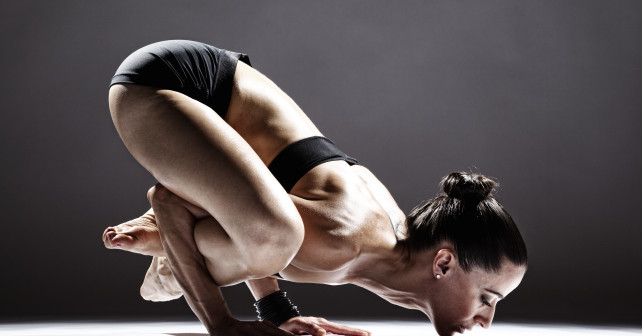By Alexia Bauer
It is a misconception that Ashtanga yoga is only for advanced students. Everyone—despite physical condition—can practice Ashtanga. By modifying the pose and by breathing, visualization and sensation, each student is able to work through the practice. The only requirement is to have a strong desire and the commitment to stay on the path—regardless of the physical and mental obstacles.
When I first started practicing yoga, someone told me Ashtanga was like gymnastics: “People jump around and are very rough with their bodies and often get injured.” I didn’t want to try Ashtanga as my idea of practicing yoga was to discover more about myself and deepen my spiritual life, not just do physical exercise.
Later that year, I went to a workshop without realizing it would be an Ashtanga one. I not only fell in love with the practice and its method but also met the teacher Kino MacGregor. Since then, Ashtanga yoga has been my daily practice, and MacGregor has been my inspiration to stay on the path.
The Ashtanga system was designed to be practiced in its traditional form: Mysore style. The name comes from the city of Mysore in India where the father of the lineage, Sri K. Pattabhi Jois, started teaching it.
In a Mysore room, the teacher doesn’t guide the class; instead, the students arrive at their leisure and are guided individually according to the needs of their bodies and progress at their own pace. First, we work on concentration and memorization of the sequence and over time, the body starts to move with more fluidity through the postures. The six series of postures are intended to be learned in order. Thus, when we encounter a difficult or uncomfortable posture, there is no escape. We simply work on whatever we need to work on, and only when our body can perform the posture, can we move onto the next one.
 One of the beautiful aspects of this system is that it is a self-practice. You can take it anywhere. You aren’t dependent on a teacher creating a sequence for you, and yet at the same time you have the support of others (when practiced in a studio or an Ashtanga- led class).
One of the beautiful aspects of this system is that it is a self-practice. You can take it anywhere. You aren’t dependent on a teacher creating a sequence for you, and yet at the same time you have the support of others (when practiced in a studio or an Ashtanga- led class).
The system is based on a method called “Tristhana,” the three, main focal points of our attention: breath, drishti (gazing point) and asana (posture). If we practice these without interruption and do not respond to the urge to stop or to avoid what appears difficult, we will learn to remain non-reactive to the fact that everything is constantly changing. We will learn to observe our minds diligently and build a sense of stability for when situations arise that could change our thoughts or emotions.
Ashtanga yoga provides each student with whatever he or she needs to find a balance between extremes to live healthier and happier in every way. Unlike other styles of yoga, the practice doesn’t often align with the idea that yoga is supposed to make us feel comfortable. Of course, Ashtanga helps us feel good in many ways, but its main purpose is to observe the mind and increase awareness and clarity. When we find obstacles within the sequence, challenging postures bring out fears, attachments and insecurities. We observe the fluctuations in our minds, and by being aware of them, we can find a way of getting out of the patterns that block us from seeing who we really are and how we react.
Ashtanga is as hard or as easy as the student wants it to be. If we react to what arises through the practice with aggression, injuries or physical and mental exhaustion may result. If we try to avoid or run away from the difficult postures by breaking the rules and skipping poses or practice, we will fall into the opposite extreme: laziness or inertia. Finding the middle path is usually what we all learn in Ashtanga, discovering our mental, physical and psychological behavior and getting to a place of acceptance and loving kindness towards ourselves and the world around us. When the mind gets in the way, we can find it hard to observe, maintain equanimity and accept the impermanence of things.
Through my Ashtanga practice, I have developed more self-awareness, self- knowledge, patience, acceptance and compassion. These are the reasons why I started practicing yoga. Ashtanga is not like gymnastics as I had heard, but a way of confronting whatever arises at the moment and bringing it into everyday situations to lead a more conscious life.
Alexia Bauer moved from her home country of Guatemala to Chicago to learn more about yoga. She teaches at Moksha Yoga Center and Tejas Yoga. See alexiabauer.com.
Bauer’s Spanish-language translation of this article here.


























2 Responses to “Ashtanga: Maintain Focus”
January 11, 2014
Ashtanga: Maintain Focus (en Español) - | Illumine Chicago[…] Read English version here. […]
April 18, 2014
DustinGreat article. I have been practicing Ashtanga Mysore under Alexia’s instruction for 3 months now and while I’m still relatively new, I have already experienced many of the benefits that Alexia describes.
It is not only the most physically rewarding practice I have found (I’ve tried P90x, barre sculpt, crossfit, a few different kinds of yoga, personal training at David Barton Gym, dance workouts), it also makes the rest of my life better.
I’m doing better at work, better able to handle stress in my personal life, and feel spiritually more connected than I have in a long time.
Namaste